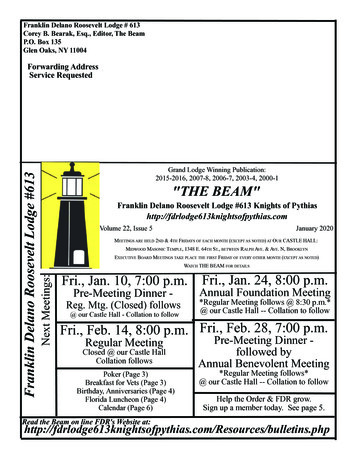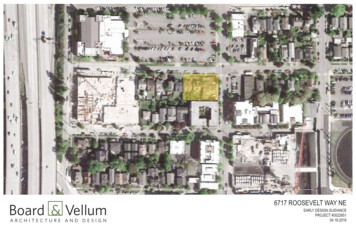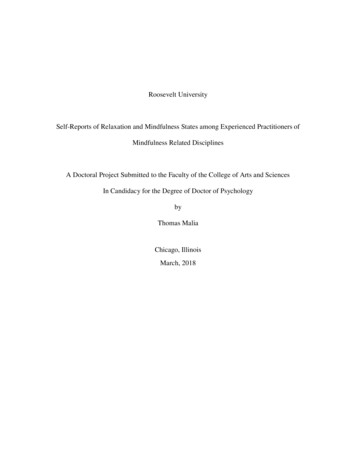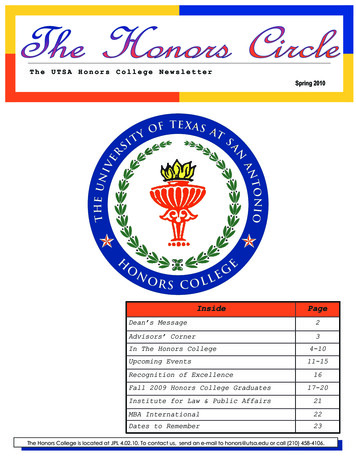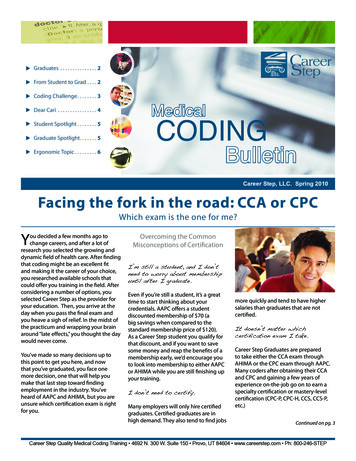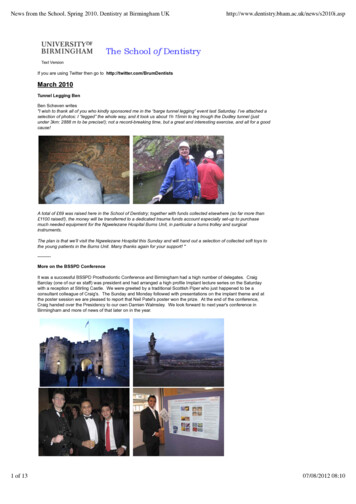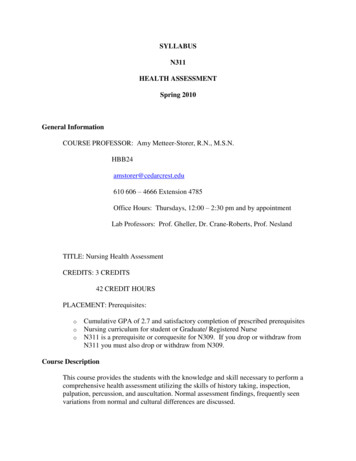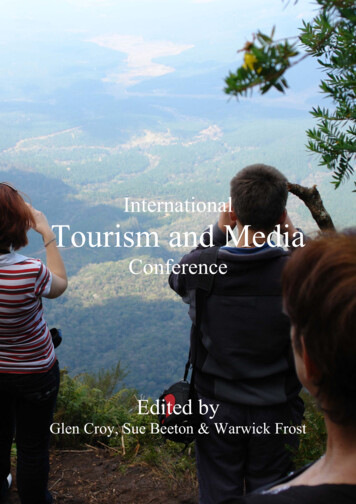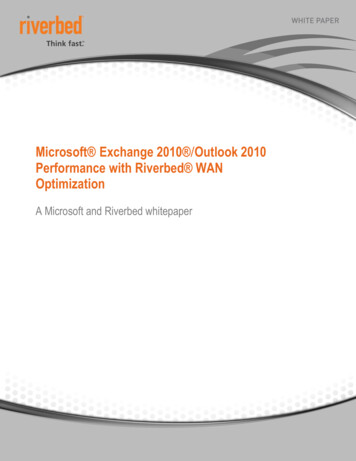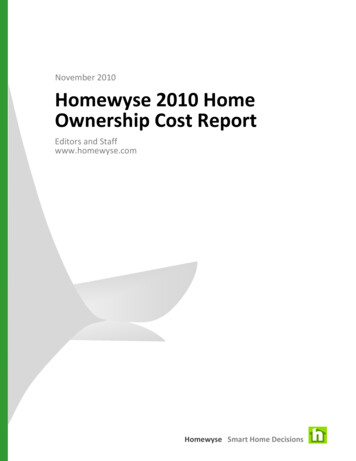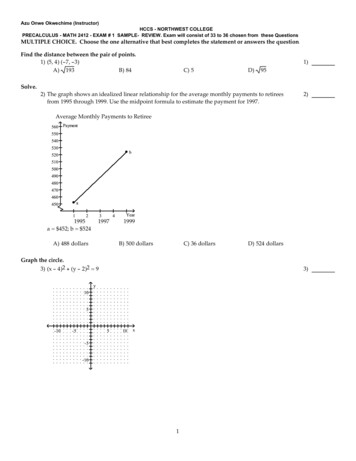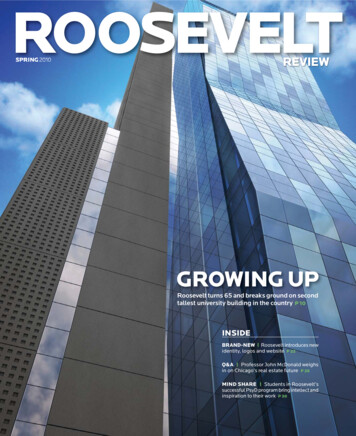
Transcription
Roosevelt turns 65 and breaks ground on secondtallest university building in the country P 10INSIDEBRAND-NEW Roosevelt introduces newidentity, logos and website P 22Q&A Professor John McDonald weighsin on Chicago’s real estate future P 26MIND SHARE Students in Roosevelt’ssuccessful PsyD program bring intellect andinspiration to their work P 30
I want students who don’t have financial meansto have an opportunity for a college education.”– ARLENE CRANDALLGIVING BACK TO ROOSEVELT THROUGH ESTATEPLANNING ARLENE CRANDALLRoosevelt University has received a significant pledge from alumnaArlene Crandall (BA, ’65; MA, ’68) through her estate plan. This commitment will fund future scholarships for students in the Collegeof Arts and Sciences and the College of Education. Crandall isone of several Roosevelt alumnae who recently earmarked giftsto the University in their estate plans. They include Bonnie Wild(BG, ’77) and Madlan McKernan (BS, ’69; MS, ’87).In high school, Crandall dreamed about going to college. Butshe had a serious roadblock – her parents would not support her.Back in the early 1960s, many people believed that girls shouldnot go to college. Crandall’s high school teacher, Ilse Glaser (BA,‘49), felt differently. Glaser called her brother-in-law, Rolf Weil,then the dean of Roosevelt’s College of Commerce and laterPresident of Roosevelt University. He suggested Crandall take acompetitive scholarship exam at Roosevelt that could enable herto “win” college funding.As they say in sports, she hit it out of the ballpark. Crandall wasawarded a four-year renewable scholarship. She received her BAin 1965, and, because she had maintained a GPA of 3.6, she alsoreceived a full-tuition graduate scholarship.Crandall’s Roosevelt education provided her with the knowledgeand skills to work in the Chicago Public Schools as a teacher andadministrator for more than 38 years. It is this devotion to educationand personal experience that inspires her to provide scholarshipsfor students from the Chicago Public Schools. “I understand theirneeds,” Crandall said. “I want students who don’t have financialmeans to have an opportunity for a college education. In a sense,this helps repay my debt of gratitude to Roosevelt University formy scholarship support and is a tribute to Ms. Glaser, the teacherwho believed in me.”Crandall’s investment in students is a tangible expression ofRoosevelt University’s mission of social justice, as it helps reducebarriers to higher education for worthy and talented students.For more information on how you cansupport Roosevelt University throughestate and planned giving, contact:Charles A. BrowningAssistant Vice President, Planned GivingRoosevelt University430 S. Michigan Ave., Room 827Chicago, IL 60605Phone: (312) 341-6455Fax: (312) 341-2319cbrowning@roosevelt.eduROOSEVELT UNIVERSITYFIRESIDE CIRCLE
ROOSEVELT REVIEW SPRING 2010CONTENTS10COVER STORYRoosevelt turns 65 and breaks ground on secondtallest university building in the country P 10INSIDEBRAND NEW Roosevelt introduces newidentity, logos and website P 22Q&A Professor John McDonald weighsin on Chicago’s real estate future P 26MIND SHARE Students in Roosevelt’ssuccessful PsyD program bring intellect andinspiration to their work P 30The skyline ofChicago’s SouthLoop will be foreverredefined whenRoosevelt’s verticalcampus opens tostudents in 2012.18 MASTER PLANNERTrustee Maureen Ehrenberg lendsher real estate expertise to thenew building on Wabash Avenue.26 Q&AJohn McDonald sits down withRoosevelt Review to discuss thefuture of Chicago real estate.ROOSEVELT REVIEW SPRING 20101
SPRING 2010 FEATURES6ON THE MAPStudents stand up tolawmakers and bring theMonetary Award Programback to Illinois schools.30INSPIRING MINDSRoosevelt’s highly selectivePsyD program teachesstudents the skills necessaryto make a difference intheir patients’ lives.36HELPING HANDSAfter recovering from arare illness and paralysis,acclaimed pianist MengChieh Liu finds fulfillmentteaching at Roosevelt.40FACULTY ESSAYJudith Gouwens exploresthe challenges of rootingmigrant youth in education.ROOSEVELT REVIEW SPRING 2010PUBLISHEREDITOR VOLUME 15, NUMBER 1Lesley D. SlavittThomas R. KarowCREATIVE DIRECTOR ASSOCIATE EDITORLaura JanotaPatrick J. LytleEDITORIAL BOARDJames Gandre Provost and Executive Vice PresidentThomas R. Karow Assistant Vice President, Public RelationsPatrick J. Lytle Assistant Vice President, Marketing WRITERS Eileen Daday, Courtney Flynn,Judith Gouwens, Laura Janota, Tom KarowDESIGN Right Angle StudioPHOTOGRAPHY Steve Becker, Bob Coscarelli,Mary Beth Manarchy, Eugene Richards, Lesley D. SlavittILLUSTRATION2 Jason Castillo, Studio2A, VOAROOSEVELT REVIEW SPRING 2010Charles R. Middleton PresidentLesley D. Slavitt Vice President, Government Relations and University OutreachPatrick M. Woods Vice President, Institutional AdvancementRoosevelt Review is published three times a year byRoosevelt University. There is no subscription fee.Roosevelt University430 S. Michigan Ave., Chicago, IL 60605(312) 341-3500 roosevelt.edu
FROM THE EDITOROn the back cover of the last issue of RooseveltReview, we featured pictures of severalRoosevelt students from the 1960s and1970s. In response to our request for information about people in the photos, CalvinStewart wrote to say he was the studentdeep in thought on the top left of the pagewhile Kevin Nduru sent a note saying hislate father was the shortest man picturedwith other students in an elevator.“I attended Roos- ROOSEVELTevelt from 1965 to1970 and then wasdrafted into theU.S. Army,” wroteStewart. “I returnedto Roosevelt in1972 and receivedmy BA degree. I amcurrently marriedwith one child and employed as a caseworkerwith the Illinois Department of Human Services. I did not realize my picture was in thisedition until another Roosevelt graduate,Thomas Chapman, called to inform me. I ama proud graduate of Roosevelt and will alwaystreasure the academic and social experiencesI had while attending the University. I haveremained in the Chicago area and currentlyreside in the Southern suburbs.”NONPROFITU.S. POSTAGEPAIDROOSEVELT UNIVERSITYRoosevelt University430 S. Michigan Ave.Chicago, IL 60605-1394Address Service RequestedWHERE ARE THEY NOW?Do you recognize these studentswho attended Roosevelt University during the 1960s, ’70s and ’80s?If so, send an email to tkarow@roosevelt.edu, and we’ll publish yourletter in the next issue of Roosevelt Review.22BRAND-NEW Roosevelt unleashes a powerful new identity.DEPARTMENTS“My dad (Ernest M. Nduru) returned to hisnative Kenya in 1960 (after receiving a BAin Psychology in 1957) and found employment with BAT Kenya,” Nduru wrote. “Heworked in the market research division ofthe company until his retirement in 1980,when he turned his attention to a farm hehad purchased on the outskirts of Nairobiwhere he raised dairy cattle. He passed awayin 2004 due to kidney failure.”4 PRESIDENT’S PERSPECTIVE45 UNIVERSITY NEWS51 INSTITUTIONAL ADVANCEMENT52 FROM THE VICE PRESIDENT53 FUNDING HIGHLIGHTSOur thanks to Calvin and Kevin for sharingtheir information. We would enjoy hearingfrom you as well. Please send your letters to:Tom KarowEditor, Roosevelt Reviewtkarow@roosevelt.edu54 SCHOLARSHIP SPOTLIGHT55 ALUMNI NEWS56 EVENTS58 WHERE RU?60 IN MEMORIAM62 2009 FISCAL REPORTROOSEVELT REVIEW SPRING 20103
4ROOSEVELT REVIEW SPRING 2010
PRESIDENT’S PERSPECTIVEROOSEVELT’S ENDURING PRESENCE By Roosevelt University President Chuck MiddletonAcademic excellence and programmatic creativity lie atthe core of everything we strive to achieve at RooseveltUniversity. They are palpable. You can sense them inthe energy of our faculty and students as they enter theelevators. You can observe them in the new logos of theUniversity generally and of intercollegiate athletics inparticular. You can hear them being acknowledged incasual conversations all across Chicago and beyond.People are key, of course. But we all know that peopledo their best work if the spaces in which they gatherare also of the highest quality and are designed to meettheir specific needs.For me there is anothersymbolism at work, onemore powerful and morecentral to the mission ofthe University. This is theperpetual reminder of allwho gaze upon it from nearand far of the critical roleRoosevelt plays in educating citizen leaders for thiscity and many other places.That role is expanding and will continue to do so inAs an historian I love old buildings, none more thanthe Auditorium Building. It has charm, it is solid andsteady, enduring many challenges of the past and readyto go on for unlimited years to come.But let’s be candid. It can be massaged only so farin meeting the academic purposes of the modern university. Some things simply cannot be done there, norcan they be accomplished in our other historic building,the Gage, up the street a few blocks.The new Roosevelt building on Wabash is criticalto our future success. It is essential if the Universityis finally to become and then sustain itself as one ofthe five or six key institutions of higher education inChicago, as I think we are on the verge of being.This new academic building is also to be as iconicon the Chicago skyline of the 21st century as the Auditorium Building was in the late nineteenth century.Indeed, Adler and Sullivan, by building the talleststructure in Chicago after the fire (and, incidentally,the heaviest building in the world at the time), might besaid to have created the notion of the Chicago skylinein the first place.Today, of course, this majestic old building hardlystands out from a distance. You have to look for it aspart of the underbrush of 10-story structures that lineMichigan Avenue and are dwarfed by much taller andnewer buildings behind.Our new building will change all that. At 32 stories, itwill be the second tallest academic building in the UnitedStates. It will stand next to and behind the AuditoriumBuilding where its glass structure will be a nice contrastto the genius of Sullivan’s façade. Taken together, thetwo will serve as a reminder of the enduring successesof Chicago architecture evolving over the centuries.part because of what we will be able to accomplish inthis new space.Think about it. Inside its glass walls stretching upfrom the street, our students will live, take state-of-theart classes in biology and chemistry labs as modern asthey get these days, study the most current theories andpractices of business, gather in neighborhoods in thesky specifically designed to create small communitiesboth intellectual and social, and enjoy the benefits ofa student union.Since this building will be connected to the AuditoriumBuilding at several levels, some students may well be ableto avoid going outside for a whole semester, never takingoff their bunny slippers, even when they go to class.There is a final symbolism that I love as well. This willbe a “green” building designed to minimize its impacton the environment. The school colors are green andwhite and how fitting it is that they play out as well inthe very nature of this large physical space.So come down and watch this transformation asit progresses. The best views are from the corner ofWabash and Van Buren.There hasn’t been this much excitement in the SouthLoop area since Adler and Sullivan put their genius towork in the 1880s. We will emulate their commitmentto excellence in architectural matters and we will usethe integrated space of the two buildings to continue themission of combining academic excellence and socialjustice that distinguishes Roosevelt from all the rest.So, take notice, world. Roosevelt University’s enduring legacy is right before your eyes.Chuck Middleton welcomes your comments. Pleaseemail him at cmiddleton@roosevelt.edu.REACHING NEW HEIGHTSThe new building on Wabash will carryforward the architectural significance setforth by Adler and Sullivan in 1890 with theconstruction of the Auditorium Building.ROOSEVELT REVIEW SPRING 20105
ROOSEVELT REVIEW SPRING 2010PHOTO LESLEY D. SLAVITT6
Students stand up to lawmakersand bring the Monetary AwardProgram back to Illinois schoolsBy LAURA JANOTA and TOM KAROWDespite tough economic times, Stephen Franklin, afirst-generation college student at Roosevelt University’s Schaumburg Campus, was doing well. His goalsof earning a bachelor’s degree in history from Rooseveltand entering law school were in sight.Then with little warning last fall, Illinois lawmakerscut 200 million from the state’s largest need-based-aidprogram for the spring 2010 semester to help reducethe state’s budget deficit.Suddenly, Franklin and 138,000 other low-incomecollege and university students in Illinois faced the possibility of losing up to 5,000 a year in Monetary AwardProgram (MAP) funding, meaning they could be forcedto drop out of school or take fewer credits this semester.Realizing that something had to be done, Franklin,along with Roosevelt students on both campuses,decided to actively campaign to have the MAP fundsrestored. Calling the cuts to MAP a social justice issue,they organized letter-writing initiatives, visited electedofficials and participated in rallies.Their hard work was successful. Late last semesterstate lawmakers agreed to appropriate an extra 200million for the MAP program and Gov. Pat Quinn, withthree Roosevelt students by his side, signed legislationto restore the money.“I’m one of the students affected by your action,”Franklin told several Illinois legislators during visitsto their offices. “It’s time to stop talking about howeducation is such a priority. Show us you really meanit’s a priority,” he said.ROADMAP TO SUCCESS Roosevelt Universitystudents from both campuses organized letterwriting initiatives, visited elected officials andparticipated in rallies to get Illinois MonetaryAward Program funds restored this semester.ROOSEVELT REVIEW SPRING 20107
His comments were echoed by others, including VinnyCascio, another Schaumburg Campus student. He joinedFranklin and 44 Roosevelt students at an October rally atthe State Capitol in Springfield. “It doesn’t matter whetheryou’re from Schaumburg or Chicago or downstate, we’reunited on this issue,” Cascio said.Roosevelt University President Chuck Middleton, who alsoaggressively worked to have MAP funds restored, praisedthose involved. “We are tremendously proud of the grassrootsefforts of our students,” he said. “They provided leadershipon a public-policy initiative and they lived the engaged lifethat we strongly encourage for all of our students.”Over the years MAP funds have helped to reduce the disparity between students who can afford college educationsand those who cannot. Available from the Illinois StudentAssistance Commission, they are awarded to undergraduatestudents who need financial help the most. Approximately47 percent of MAP grant recipients come from families withan annual household income of 20,000 or less.“We were fighting forour future – everyone’sfuture,” said Rooseveltstudent Josh Emerick, apolitical science major,who was also involved.“The University totallysupported our ideas.”Those ideas werepart of a comprehensive and coordinatedcampaign that used students, administrators,ROOSEVELT UNIVERSITYtrustees and alumni. ForSTUDENT DIMITRA GEORGOUSESexample, the student-runRU Sociological Societycollected nearly 250 letters that were sent to dozens of statesenators and representatives. Some of the other initiativeswere a Roosevelt website dedicated to MAP issues, free busesso students could attend rallies in Springfield, Chicago andPeoria, a video which was on You Tube and Facebook, posters signed by students and delivered to House Speaker MikeMadigan, emails to alumni asking them to contact theirlawmakers, newspaper interviews, informational meetings at both campuses and T-shirts proclaiming “Keep ILStudents on the MAP.”“It’s rather unusual these days to see students organizearound one issue and let their voices be heard,” said DonaldMcNeil, chair of the Illinois Student Assistance Commission. “The support MAP has received from Roosevelt andstudents across the state – from four-year publics, privateliberal arts colleges, community colleges and proprietaryschools – shows what can be done when you come togetherwith a common interest.”Danielle Medine, a MAP student and finance and accounting major, went up to Gov. Quinn at a rally in Chicago to lethim know how the loss of her MAP grant would affect her“This is notsimply aboutgiving someschools money.It’s aboutour future asa society.”8ROOSEVELT REVIEW SPRING 2010
A WELL-DESERVED VICTORY The drive to keep state funding in place thissemester for 138,000 low-income college and university students in Illinoissucceeded, thanks in part to the efforts of engaged Roosevelt students.Percentage of Student Population Receiving MAP ability to pay for her education. “I had mixed feelings aboutthe governor at first, but was pleasantly surprised that hewas so enthusiastic about our efforts,” said Medine, who waswearing her green Roosevelt University “Keep IL Studentson the MAP” shirt during the rally.Quinn also met privately with Middleton and the presidents of Loyola University, Northern Illinois University andIllinois Central College. At the meeting, Middleton said hisbiggest fear was that if students dropped out of universitiesor colleges for financial reasons, they would never returnto complete their degrees.“That was an historic meeting and the first time in mymemory that presidents representing public, private andcommunity college institutions in Illinois joined forces andinformed the governor of their concerns about an issue thathas broad implications and consequences for college students across the state,” said David Tretter, president of theFederation of Independent Illinois Colleges and Universitiesand an activist in Springfield for the last 20 years.“I think people realize that what we were able to do wasgreat,” said Dimitra Georgouses, a political science major atthe Chicago Campus who stood on a platform during the rallyin Springfield and led shouts of “save MAP now” along withhundreds of other students from across the state. “However,we may have to do something even bigger in the future tosave MAP for other students,” she said. “I plan to be there tofight because if we don’t make higher education a priorityeverything else in our society will start to crumble. This isnot simply about giving some schools money. It’s about ourfuture as a society.”3020100 Total MAP Distribution 29.41% 39.02% 26.89% 4.68%SOURCE: W W W.SAVEILLINOISMAPGRANTS.ORGROOSEVELT REVIEW SPRING 20109
ROOSEVELT REVIEW SPRING 2010ERTICAROOSEVELT GOES10Roosevelt beginsconstruction ona dramatic newbuilding that willforever transformthe face of theUniversity
On April 17 Roosevelt University will break ground ona 32-story academic buildingthat will be the second tallest university building in thecountry and the sixth tallestin the world. A unique verticalcampus, it will have classrooms, laboratories, offices,dorm rooms, a dining hall,fitness facilities and studentservices all under one roof.The groundbreaking ceremony,being held on the 65th birthday of Roosevelt, will celebratethe most important development in the University’s history since the AuditoriumBuilding was acquired in 1946.Roosevelt is not just constructing a building; it is creating agreat university experience.WHY WE’RE BUILDING ITThe new building will meeta need for increased space atRoosevelt’s Chicago Campusfor academics, student lifeand student housing. The University projects there will bea 50 percent increase in thenumber of full-time equivalent students at the ChicagoCampus between 2007 and2017. The University’s existingfaci
ROOSEVELT UNIVERSITY FIRESIDE CIRCLE Roosevelt University has received a significant pledge from alumna Arlene Crandall (BA ’6, 5 M; A, ’68) through her estate plan. This com-mitment will fund future scholarships for students in the College of Arts and Sciences and the
